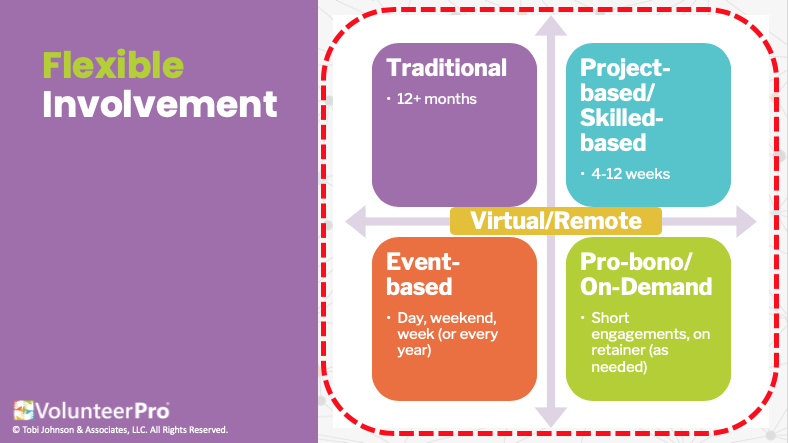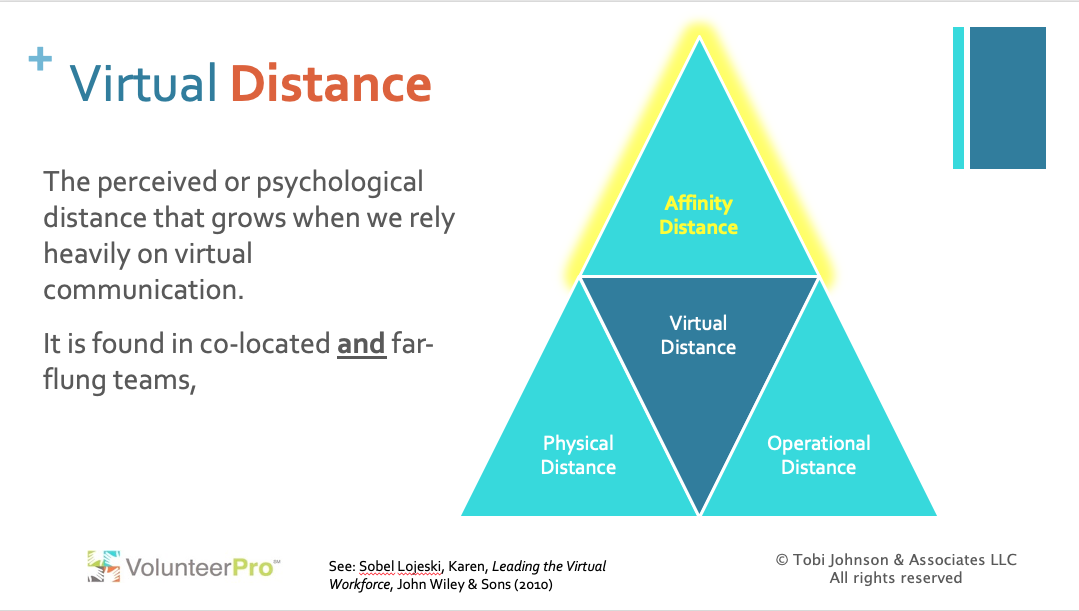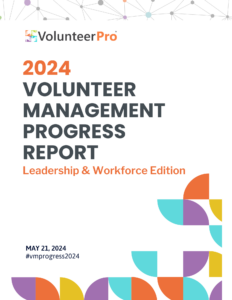 Your Weekly Plan for Managing Virtual
Your Weekly Plan for Managing Virtual
& Remote Volunteers
Because of the COVID-19 pandemic and social distancing guidelines, many creative volunteer organizations have transitioned to engaging remote volunteers.
While this is a wonderful way to support a resilient organization, it isn’t always easy. Volunteer strategies have had to be built over from the ground up, with new roles, new position descriptions, new training, and new ways of working.
For anyone who may have thought that working remotely is somehow easier, they’ve quickly realized that’s not the case.
But there are things you can do to manage your time wisely and make the most of the opportunities that become available when you take volunteering online.
Building Flexible Roles for Remote Volunteers
In today’s uncertain and ever-changing context, it’s hard to predict the future. So, flexibility is a key to sustainability.
If you remain flexible, you will become resilient. If you are too rigid, you will break.
To stay resilient, it’s important to maintain flexibility in your volunteer roles and be sensitive to the fact that people are stressed and overwhelmed.
If you offer a variety of time frames and projects, you indicate to your supporters that you understand and empathize with their current situation. This creates an open environment where people are more likely to trust the process and that their needs are as important as the organization’s requirements.
There are four key areas where volunteers might be involved.
1) Traditional Roles – These are generally longer-term roles of 12+ months where volunteers commit to a specific schedule or minimum number of hours per week or month. These are common in direct service organizations.
2) Project-based/Skilled-based Roles – These roles are shorter in length and involve projects with a 4-12-week time span. They often engage volunteers with special skills that can be put to use in the short term, such as marketing or instructional design.
3) Event-based Roles – These are generally opportunities that involve a day, weekend, or week of service. Also known as “episodic” volunteering, volunteers may serve one time or return over year to assist with the same event such as fun runs, galas, or other fundraising events.
4) Pro-bono/On-Demand Roles – These highly-specialized roles often require professional training and certifications, and volunteers can contribute time through short engagements or even on retainer and be called upon as needed. Pro-bono legal assistance is the most common of these, but human resources consulting might be another type of role in this category.
Flexible Roles for Volunteers
What’s important to note is that any of the kinds of volunteer roles mentioned above can be converted to a virtual or remote opportunity.
In addition, while many conflate the terms “virtual” and “remote,” they are slightly different. And, by understanding both, you can also better see the wide roles volunteers can play even when they are not at your office.
Virtual volunteers perform tasks online using computers, tablets, or smart phones. Virtual volunteers might be involved in developing or presenting online training, writing marketing copy, updating volunteer materials, developing and deploying surveys, entering and analyzing data, managing online communities, etc. Anything that can be done using the internet might be considered a virtual role.
Remote volunteers, on the other hand, perform tasks off site. While these might also be virtual roles, they might also not involve online work. Remote volunteers might make phone calls, sew masks, assemble informational packets or kits, collate hard copy training handouts, organize and archive materials, etc.
Managing for Virtual Distance
One of the most challenging issues for those responsible for leading remote and virtual volunteers is that of time management.
In addition, virtual volunteer coordination requires different tools that may, or may not, have been used when volunteers worked on site. Tools for conference calls, video chats and screen sharing, document sharing, team scheduling, project management, email communications, group chats, and team-building tools are all helpful.
Without the natural reminders baked into face-to-face collaboration and in-person communications, coordinators must not only utilize smarter tools, but also develop a more purposeful strategy for management.
Developing a weekly calendar of tasks can be an immense help in keeping remote volunteer teams together and functioning at a high level.
The volunteer coordinator must become an online community manager.
Why does it matter?
Researchers have found that virtual distance can have a deep impact on team productivity.
Digital communication presents major roadblocks to forming the deep relationships necessary to learn and work effectively together. Virtual Distance is comprised of …
- Physical Distance – Location issues related to space and time
- Operational Distance – Psychological gaps that grow due to issues that arise in workplace
- Affinity Distance – The emotional disconnects between team members due to lack of relationship formation and development
Types of Virtual Distance
Different types of distance hinder connection, but specific steps can be taken to reduce the perceived or psychological distance that grows when we rely heavily on virtual communication, otherwise known as virtual distance.
By far, affinity distance is the most important to address, and fostering relationships is the most powerful way to reduce distance.
Researcher Karen Sobel-Lojeski, in her book Leading the Virtual Workforce: How Great Leaders Transform Organizations in the 21st Century, notes that when virtual distance is high several negative impacts can occur:
- Innovative behaviors fall by over 90%
- Trust declines by over 80%
- Cooperative and helping behaviors go down by over 80%
- Role and goal clarity decline by 75%
- Project success drops by over 50%
- Organizational commitment and satisfaction decline by more than 50%
So, it’s important that those who lead remote volunteers have a plan in place to reduce the psychological feeling of virtual distance through better communications and better team-building.
In order to develop and maintain purposeful (and manageable communications), it helps to have a weekly plan in place.
A Simple Framework for Managing Virtual & Remote Volunteers
Online community management includes a host of activities that may or may not be used in in-person volunteer management.
They include:
- Strategy – This includes establishing realistic goals and collecting and analyzing data about online participation (e.g., email open rates, video views, community posts and participation, etc.).
- Growth – This includes inviting volunteers to participate, whether it be to assume a new role or to engage in the online tools you have established. Either way, it will take outreach and encouragement to facilitate uptake in a digital or remove volunteering environment.
- Moderation – Similar to growth, moderating is about encouraging positive and community-centric behavior through active engagement, usually online (e.g., establishing and reinforcing guidelines, initiating conversations, resolving disputes, answering questions, etc.).
- Content – Developing and distributing entertaining, informative, and persuasive content at regular intervals is key to maintaining engagement. While many managers will share calls to action and instructions regularly, other kinds of more emotionally based content are less common, but as important to reducing virtual distance. Storytelling and simple fun are great tools to keep content interesting.
- Relationships – Developing connections with volunteers, and fostering volunteer leaders, is also vital to deepening connections throughout a remote volunteer team. It can’t all be based on the work of one person, so deputizing volunteers to help lead teams and team-building activities is an essential element for success. The hallmark of a healthy online community is one that communications happen organically without the regular intervention of a manager.
- Special Events – To keep a remote team engaged, it also helps to create a team rhythm that is punctuated by a little excitement in the form of events. These might be online trainings, brainstorming sessions, or simple socializing online. There are a myriad of creative ways to team-build online. Let your creativity be your guide.
- Technology – Planning for, assessing, and implementing technology tools is also a key part of digital success. This includes platform maintenance and optimization of its features for a better user experience. You also need to ensure that volunteers feel comfortable and confident using any new tech you bring onboard. This generally means training and coaching as well as LOTS of positive reinforcement.
So, how do you manage it all?
A Weekly Plan for Managing Remote Volunteers
If you’re working online with remote volunteers, you can get a better handle on your time by planning out your week, day by day.
That way, you can ensure that some of the smaller community management elements don’t fall through the cracks.
Consider setting a weekly calendar something like this …
Dedicate some time each week to work on the tasks in the six key focus areas. You may tackle specific things every day or on a certain day of the week, so include those tasks every week.
Then, get specific about what exactly you will do each day. Is it to reach out directly to 10 volunteers? Is it to post a newsletter? Is it to host a webinar or Facebook Live? Is it to meet with volunteer leaders? Is it to review email open rates? Whatever you plan to do, mark it on the weekly calendar.
Then, review for gaps and areas that you are missing.
If you are just transitioning to working with remote volunteers, the follow are percentages of time you might want to spend on each task.
- Strategy – 5%
- Growth – 40%
- Moderation – 25%
- Content – 5%
- Relationships – 15%
- Special Events – 5%
- Technology – 5%
As you become more established, the growth and moderation time make decrease, and the time reserved for content and events may increase.
If you dedicate a little bit of time to all seven areas each week, you will find it easier and easier to stay on point. Also, you’ll find that you’ll begin to develop repetitive systems that you can teach and delegate to others and begin to grow leadership and ownership of volunteers supporting their fellow volunteers.
Although the current pandemic has cause deep disruptions in how you do business, it doesn’t mean you can’t be successful in the current climate.
All it means, is that you may need to approach your work differently and focus on areas that may have been neglected in the past. If you use the framework above, you’ll be miles head of others who are still floundering and well on your way to developing a strong, self-sufficient remote volunteer team that gets things done.
Plus, by continuing to engage remote volunteers, you’ll be stronger than ever and ready to hit the ground running when you emerge on the other side.









